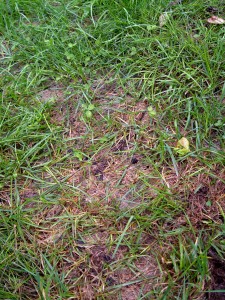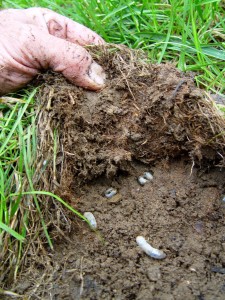Grub Alert
October 4th, 2011
Your lawn should be looking pretty good after all of the rain this year (one of the few positives from the incessant deluges).
The one bugaboo that might get you, though, is beetle grubs.
Take a good look at the lawn to make sure you don’t have patches that are noticeably thinner or browner than the rest, or worse yet, browning out altogether. If skunks or crows seem to be very interested, that’s another oh-oh moment.
I was on my way to the vegetable garden Saturday and noticed a couple of islands of brown in an otherwise sea of green.
When I gave the browned-out blades a tug, the whole section pulled up like a piece of carpet. Underneath were dozens of well-fed grubs – those fat, white, inch-long wormy-like bugs curled up into a C-shape.
It looked like a community of grubs lying out on the beach… and their lunch was my grass roots.
A few grubs per square foot isn’t a big deal. Damage is barely noticeable. But when the numbers get up to 5 or 10 or more per square foot like this, it’s enough to completely kill whole patches of lawn.
I’m not too surprised that numbers are up – at least in my yard. Damp soil in late summer is great for egg hatch.
You might be aware that grubs are the larval stage of beetles. But what few people realize is that not all grub outbreaks are the result of Japanese beetles. Our lawns are just as often victims of northern masked chafer beetle grubs and to a lesser extent, Asiatic garden beetles and green June beetles.
This usually answers the mystery: “I didn’t see hardly any Japanese beetles this summer, so how comes I’m getting all of these grubs now?” Reason: The grubs are probably baby northern masked chafer beetles.
Unlike Japanese beetles, which are shiny copper in color and fly around in broad daylight doing highly noticeable damage to some 200 species of landscape plants, masked chafer beetles are more of a paper-bag brown and come out after sunset. We don’t see them, and they don’t do anywhere near the damage of Japanese beetles.
So just because you didn’t have a Japanese beetle problem this summer doesn’t get your lawn off the hook for grub damage now.
This little ID mix-up also answers the question why that organic milky spore disease didn’t seem to work. The bacteria in that product is fairly effective against Japanese beetle grubs but not against masked chafer beetles.
The grubs of both of these beetles look almost identical. The only way to tell the difference at this stage is to look at the hair pattern on the butt ends under a hand lens. Japanese beetle grubs have a V-shaped hair pattern, while the masked chafers have a random hair pattern. I doubt many people are interested in that level of investigation.
What you probably care about is what to do.
The difficult decision here is that the most effective way to stop grubs is to prevent them by applying chemicals such as imidacloprid, halofenazide or thiamethoxam (i.e. GrubEx, Mach2, etc.) But they work best when they’re applied from mid-June to mid-July – before you know if you’re going to actually have a grub problem.
If you wait until damage is apparent, you’re down to two more harsh chemicals that work for only short periods – Sevin (carbaryl) or Dylox (trichlorfon).
I really don’t like to use any chemicals, so my usual grub strategy is to pull off any dead patches, smash the exposed grubs with a blunt instrument and replant with new grass seed. You can do that now (like I did over the weekend) or deal with it in spring.
In a few weeks, the grubs go down deeper into the soil for winter. Damage stops. But then they come back up in spring to do a bit more grass-root feeding until they begin to pupate into adults in late May. They’re almost impossible to kill with anything other than blunt object in spring.
Michigan State entomologist Terry Davis offers some solid advice if you’re thinking about using any products. Here’s what he writes on the MSU turfgrass website:
1.) Unless you do something to kill the grubs, it won’t do much good to just replant grass. The grubs likely will eat the new grass.
2.) You’ll find supposed grub controls in the store that won’t do any good now. Tops on the list: products that contain only lambda-cyhalothrin, gamma-cyhalothrin, bifenthrin, deltamethrin, cyfluthrin or permethrin. These are fine for killing surface insects but not root-feeders.
3.) Some products contain one or more of those and a preventive chemical such as imidacloprid. They won’t do much now either. It’s too late.
4.) Carbaryl and trichlorfon are the two most effective “rescue” treatments that’ll work now. Brands you might run across are Gardentech Sevin Lawn Insect Granules (carbaryl) and Bayer Advanced 24-Hour Grub Killer Plus (trichlorfon). Both of these need to be watered in well immediately (an hour under a sprinkler), none kill in a day (5 to 14 days is more realistic), and you should expect 60 to 70 percent control (not 100 percent).
5.) You can buy parasitic nematodes through some garden catalogs that infect and kill grubs. Results have been inconsistent, though. To work best, the living nematodes have to go down in early fall when the soil temperatures are still around 70 degrees. The most effective type: Heterorhabditis bacteriophora.
In the long run, three things you can do to reduce the likelihood of grub problems:
1.) Cut the lawn high. Beetles prefer laying eggs in short turfgrass. Mow 3½ to 4 inches tall.
2.) Don’t irrigate. Beetle eggs hatch best in damp soil. I’d rather have brown grass in summer that bounces back in fall than green grass all summer that gets eaten to death in fall.
3.) Plant more trees. Beetles like to lay eggs in sunny spots. If your yard becomes shadier, the grubs will end up in your neighbor’s sunny front yard.









